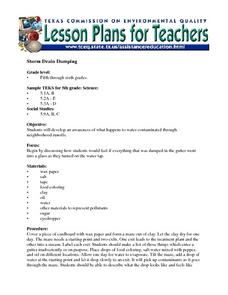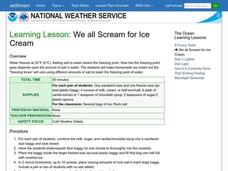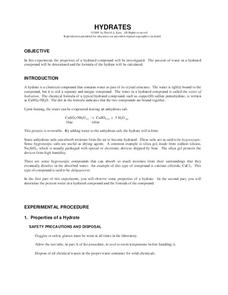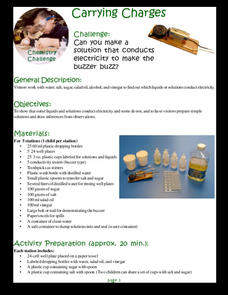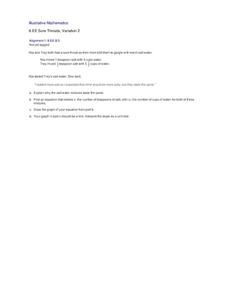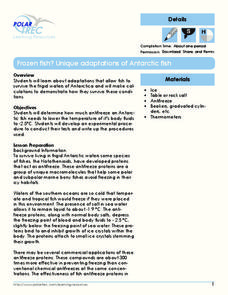Curated OER
Book: Germany
Students, after reading Chapter One in the book, "Germany," analyze and recreate the political boundaries as well as the physical features of the nation of Germany with the assistance of play-doh or salt dough. In groups, they create...
Curated OER
Temperature Effects on Solubility
Students determine the solubility of salt in water at three different temperatures and graph the results. They use the following skills: observing, inferring, and graphing.
Curated OER
Snow Crystal Picture
Students color a snow scene and use salt to make snow crystals. In this art activity students add Epson Salt to water and paint the snow background. After drying the salt with sparkle like real snow.
Curated OER
Solar Still
In this ocean water worksheet, students complete a simulation involving salt, water, string, and more to simulate what happens to salt when the salt water evaporates. Students also answer 4 questions.
Curated OER
Give Me a Hand, I'm "Thumb-body" Special
Students label the bones in the hand, create a model of the hand, compile a set of fingerprints, and explore the importance of the thumb. In this anatomy of the hand lesson plan, students participate in six hands-on activities to...
Curated OER
Storm Drain Dumping
Students conduct an experiment to show how water gets contaminated through neighborhood runoffs.
Curated OER
How Do Geology and Physical Stream-bed Characteristics Affect Water Quality?
Students examine geological bedrock in landscape regions and collect data. In this investigative lesson students retrieve data on the Internet then interpret, and graph it.
Curated OER
Lab 23-Follow Up Questions-Conductivity
In this conductivity learning exercise, students answer post lab questions about substances that transferred electrons resulting in electricity flowing through the conductivity leads use to test each substance.
Curated OER
Make It Rain!
Students complete an experiment. In this precipitation activity, students complete an activity where they make rain in a jar.
Curated OER
Ice
Students examine the different propereties of ice, such as freezing temperature. In this scientific lesson students complete several activities using ice, like making ice cream.
Curated OER
We All Scream for Ice Cream
Pupils make ice cream while experimenting with the freezing point of water. They experiment with different amounts of salt.
Curated OER
Blueprint Paper
Students investigate chemical reactions involved in making a blueprint. In this blueprint paper lesson plan, students expose blueprint paper with writing that has been soaked in a solution of potassium ferricyanide and iron (III)...
Curated OER
Celebrate Martin Luther King Jr. Day in the Most Meaningful Way
Lead your class on a journey into the Deep South so that they understand the true meaning of what inspired this holiday.
Texas State Energy Conservation Office
Investigation: Heat it Up!
This demonstration of solar ponds can be used in an earth, environmental, or physical science setting. Lab groups set up a solar pond and model how it is able, due to a salt concentration gradient, to maintain heat for future use.
Chymist
Hydrates
What occurs when a hydrate is heated? Lead your class in exploring the answer to this question as they investigate the properties of a hydrated compound. They heat copper(II) sulfate pentahydrate and evaporate the water byproduct to...
Curated OER
Summer Intern
Your young apprentices build a function describing the percent concentration of salt in a brine. The rational function is then related to the parent function, y= 1/x, and graphed. Finally, the apprentices predict the amount of fresh...
Sciencenter
Carrying Charges
What's all the buzz about electricity? Scholars take part in a scientific activity to test the conductivity of liquids and solutions. They first see if water, salad oil, alcohol, and vinegar cause a buzzer to buzz when electrodes are...
Illustrative Mathematics
Sore Throats, Variation 2
What does math have to do with a sore throat? When you mix water and salt you have a great review of how to represent proportional relationships by an equation or graph. Here the proportions of the mixtures may be different, but the...
Polar Trec
Frozen Fish? Unique Adaptations of Antarctic Fish
Some fish contain proteins that act like antifreeze in order for them to live in the frigid waters of Antarctica! High schoolers determine how much antifreeze a fish needs to lower its body temp to -2.5 degrees. Teachers act as a...
LABScI
Freezing Point Depression: Why Don’t Oceans Freeze?
Can you go ice fishing in the ocean? Learners examine the freezing point of different saltwater solutions. Each solution has a different concentration of salt. By comparing the freezing points graphically, they make conclusions about...
Curated OER
Melting and Freezing Behavior
Students investigate melting and freezing behavior in substances. For this melting and freezing points lesson plan, students perform experiments to test the impact of various salts on the freezing point of water, they test the impact of...
Exploratorium
Indicating Electrolysis
Sure, your learners know water is made up of two molecules, but watching them separate helps the class see the construction like never before. This resource provides directions on how to build a simple electrolysis device using a...
National Institute of Open Schooling
Solutions
Aqua regia, or royal water in Latin, is a solvent that can dissolve solid gold and platinum into a solution. Activity nine in a series of 36 allows classes to learn, through readings and answering questions, what a solution is and the...
American Chemical Society
Entropy and Enthalpy Changes
My room isn't messy — it's a scientific experiment in entropy! Scholars investigate entropy, enthalpy, and spontaneity through a guided procedure and set of questions. The lesson connects the Second Law of Thermodynamics, energy transfer...







